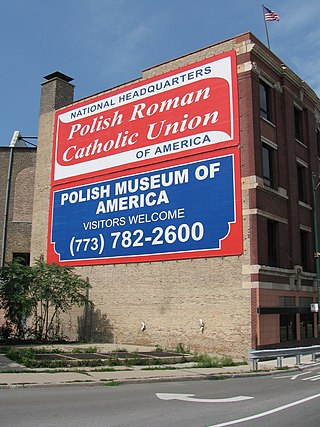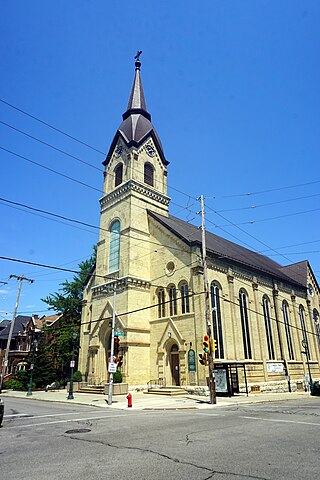
Polish Americans are Americans who either have total or partial Polish ancestry, or are citizens of the Republic of Poland. There are an estimated 8.81 million self-identified Polish Americans, representing about 2.67% of the U.S. population, according to the 2021 American Community Survey conducted by the U.S. Census Bureau.

The Polish Roman Catholic Union of America (PRCUA) is the oldest Polish American organization in the United States. Currently licensed to sell its products in 27 states, it is a fraternal benefit society providing financial security to its members through competitive life insurance and annuities, and offering opportunities for cultural, educational and spiritual growth.

Archer Heights is a community area in Chicago, Illinois, one of the 77 official community areas of Chicago.

The Basilica of Saint Hyacinth is a historic church of the Roman Catholic Archdiocese of Chicago, located at 3636 West Wolfram Street in the Avondale neighborhood of Chicago, Illinois.

St. Stanislaus Roman Catholic Oratory is a Roman Catholic parish in the historic Mitchell Street District of Milwaukee, Wisconsin. It was designed by Polish nobleman Leonard Kowalski, one of Milwaukee's early Polish residents, who took the name Leonard Schmidtner and spoke German.

Vincent Barzyński, C.R. (1838–1899) was a Polish-American Roman Catholic priest and organizer of the Polish-American community.

The Polish cathedral architectural style is a North American genre of Catholic church architecture found throughout the Great Lakes and Middle Atlantic regions as well as in parts of New England. These monumentally grand churches are not necessarily cathedrals, defined as seats of bishops or of their dioceses.

Saint Mary of the Angels is a historic church of Roman Catholic Archdiocese of Chicago in Chicago, Illinois.

Saint Stanislaus Kostka Catholic Church is a historic Polish church of the Roman Catholic Archdiocese of Chicago that is located at 1351 West Evergreen Avenue in the Pulaski Park neighborhood of Chicago, Illinois, United States. It is designated as the Sanctuary of Divine Mercy of the Archdiocese.

St. Hedwig's Church is a historic parish church of the Roman Catholic Archdiocese of Chicago located in Chicago, Illinois. Constructed in the grand Polish Cathedral style, it is one of the many monumental Polish churches visible from the Kennedy Expressway. The church is located at 2226 North Hoyne Avenue.

St. Josaphat is a historic church of the Roman Catholic Archdiocese of Chicago located at 2311 North Southport Avenue in Chicago, Illinois.

St. Hedwig's Roman Catholic Church, is a church and former parish of the Roman Catholic located at 1702 N. Humboldt Ave. on Milwaukee, Wisconsin's East Side at the center of the East Brady Street Historic District, in the Roman Catholic Archdiocese of Milwaukee.

Polish Downtown was Chicago's oldest and most prominent Polish settlement. Polish Downtown was the political, cultural and social capital of Poles in Chicago and of other Polish Americans throughout North America. Centered on Polonia Triangle at the intersection of Division, Ashland and Milwaukee Avenue, the headquarters for almost every major Polish organization in the United States was clustered within its vicinity, beginning with the Polish National Alliance to the Polish Daily News.
St. Stanislaus Kostka Church in Wilmington, Delaware, United States, was founded November 23, 1913, as a Roman Catholic Church on the East Side of Wilmington to serve the needs of a growing Polish immigrant community. The Church was a part of the Diocese of Wilmington, until its closure on February 15, 2009.

The Basilica of Saint Stanislaus Kostka is a historic church of the Roman Catholic Diocese of Winona in Winona, Minnesota, United States, and a prominent fixture on the city's skyline. Within the diocese it is known as Saint Stan's. It was listed on the National Register of Historic Places in 1984 as Church of St. Stanislaus–Catholic. It was designated as a Minor Basilica of the Roman Catholic Church on November 10, 2011 by Pope Benedict XVI.
The Kashubian diaspora resulted from the emigration of Kashubians mainly in two waves occurring in the second half of the 19th century. The majority of Kashubian emigrants settled in the United States; others emigrated to Canada and Brazil. An online genealogical project, "The Great Kashubian Migration," is devoted to tracking their settlement patterns. Their reasons for emigration varied. Until the Franco-Prussian War, Kashubians emigrated primarily for economic reasons. After the Franco-Prussian War and especially due to the Kulturkampf, Kashubian emigration accelerated as socio-political factors came into play. In his 1899 book, Statystyka ludnosci kaszubskiej, the Kashubophile linguist and sociologist Stefan Ramult estimated that 130,700 Kashubians were living in the Americas.
St. Casimir Church is a parish church of the Roman Catholic Archdiocese of Baltimore located in the Canton neighborhood of Baltimore, Maryland.
The history of Poles in the United States dates to the American Colonial era. Poles have lived in present-day United States territories for over 400 years—since 1608. There are 10 million Americans of Polish descent in the U.S. today. Polish Americans have always been the largest group of Slavic origin in the United States.
In 2023, Polish Americans are most heavily concentrated in the Upper Midwest and Northeast regions of the United States. As the second most Polish populated state, Michigan follows closely behind Wisconsin with 784,200 people identifying as Polish, or 7.82% of the state's population, identifying as Polish. Many of these Polish Americans live in the Metro Detroit area of Michigan.

Peter Kiołbassa was a Polonia activist and Democratic politician in the city of Chicago, serving as Chicago Treasurer and Commissioner of Public Works. Nicknamed "Honest Pete" because he refused to take city funds from financial decisions made as Treasurer, he broke from the tradition of his predecessors. He was the first Pole to be elected to such positions in the city. He was a major organizer of St. Stanislaus Kostka Church, and worked as president of the Polish Roman Catholic Union of America, in order to regain the Poles' loyalty to the Roman Catholic Church.




















